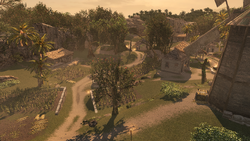Stormbeast (talk | contribs) mNo edit summary |
Sadelyrate (talk | contribs) m (Sadelyrate moved page Sugar plantations to Sugar plantation over redirect: Consistency) |
||
| (16 intermediate revisions by 12 users not shown) | |||
| Line 1: | Line 1: | ||
| − | {{Era| |
+ | {{Era|Locations}} |
{{WP-REAL|Sugar plantations in the Caribbean}} |
{{WP-REAL|Sugar plantations in the Caribbean}} |
||
| ⚫ | {{Dialogue2|Adéwalé|And there are a few [of the crew] talking about meeting with Master Kidd to steal from a nearby plantation.|Edward|A plantation? That's ambitious.|Profitable too, if we can manage it.|[[Adéwalé]] and Edward Kenway discussing the risks and rewards of stealing from a sugar plantation, 1715.|Assassin's Creed IV: Black Flag}} |
||
| − | {{Spoilerhd}} |
||
| + | [[File:FC Port-au-Prince plantation.png|thumb|250px|A sugar plantation on Saint-Domingue]] |
||
| ⚫ | |||
| ⚫ | |||
| ⚫ | {{Dialogue2|Adéwalé| |
||
| ⚫ | |||
| − | During the early 18th century, the [[Peter Beckford|Beckford]] and {{Wiki|Drax Hall Estate|Drax |
+ | During the early 18th century, the [[Peter Beckford|Beckford]] and {{Wiki|Drax Hall Estate|Drax}} estates owned the majority of the plantations in the Caribbean. Because of the possible rewards obtainable from a successful raid, sugar plantations were a promising, if risky, target for [[Piracy|pirates]].<ref name="AC4">''[[Assassin's Creed IV: Black Flag]]''</ref> |
| + | Up until September 1715, the [[Templars|Templar]] [[Julien du Casse]] owned a small plantation on the island of [[Great Inagua]]. After the pirate [[Edward Kenway]] killed du Casse and took the cove for himself, the plantation was maintained by the pirates.<ref name="AC4"/> |
||
| − | ==Reference== |
||
| + | |||
| − | *''[[Assassin's Creed IV: Black Flag]]'' |
||
| + | During the 1730s, there were a number of sizable plantations on and around the island of [[Haiti|Saint-Domingue]], including those at [[Wellington]] and [[Tortuga]], as well as a number near the town of [[Port-au-Prince]].<ref>''Assassin's Creed IV: Black Flag - [[Freedom Cry]]''</ref> |
||
| ⚫ | |||
| + | |||
| − | [[Category:Landmarks]] |
||
| + | ==References== |
||
| + | {{Reflist}} |
||
| ⚫ | |||
[[Category:Slavery]] |
[[Category:Slavery]] |
||
| ⚫ | |||
Revision as of 16:22, 18 April 2019
- Adéwalé: "And there are a few [of the crew] talking about meeting with Master Kidd to steal from a nearby plantation."
- Edward: "A plantation? That's ambitious."
- Adéwalé: "Profitable too, if we can manage it."
- —Adéwalé and Edward Kenway discussing the risks and rewards of stealing from a sugar plantation, 1715.[src]

A sugar plantation on Saint-Domingue
Throughout the 17th and 18th century, sugar plantations were highly prevalent and profitable in the Caribbean. Typically owned by a single family, they were normally worked by said family's slaves, and guarded by a sizable contingent of soldiers.
During the early 18th century, the Beckford and Drax estates owned the majority of the plantations in the Caribbean. Because of the possible rewards obtainable from a successful raid, sugar plantations were a promising, if risky, target for pirates.[1]
Up until September 1715, the Templar Julien du Casse owned a small plantation on the island of Great Inagua. After the pirate Edward Kenway killed du Casse and took the cove for himself, the plantation was maintained by the pirates.[1]
During the 1730s, there were a number of sizable plantations on and around the island of Saint-Domingue, including those at Wellington and Tortuga, as well as a number near the town of Port-au-Prince.[2]
References
- ↑ 1.0 1.1 Assassin's Creed IV: Black Flag
- ↑ Assassin's Creed IV: Black Flag - Freedom Cry
| |||||||||||||||||||||||||||||||
